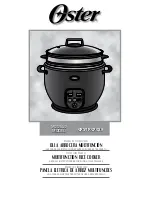
1.3 About use
The appliance is intended solely for use in the
household and must not be put to any other uses.
Use the appliance to prepare meals only. It must not
be used to heat up the room in which it is installed.
Use of a gas cooker generates
heat and humidity
in the room where it is installed. This is why atten-
tion must be paid to good kitchen ventilation.
The
natural ventilation openings
must be kept
unobstructed. Prolonged use of the appliance
with several or all rings may call for additional
ventilation such as opening a window or a door,
or stronger air extraction by an extractor hood.
To guarantee good combustion, the room in
which the appliance is installed must have
a minimum volume of 20 m
3
and must possess
a door that opens outdoors or a window that
can be opened.
Only
ever use the burners
after placing pots and
pans on them. Do not heat up any empty pots
or pans
; this may result in a build-up of heat. Use
pots and pans with thicker bottoms because heat
distribution is particularly improved in the low
setting. The better the size of pots and pans is
adapted to the burner size, the better the heat of
the gas flame will be exploited and the more costs
will be saved.
Cooking vessels with curved bottoms, e.g. woks,
must not be used.
It is not permitted to use roasting pans, frying pans
or grill stones heated simultaneously by several
burners because the resulting heat build-up may
damage the appliance.
Switch the burners to the low setting whenever you
remove pots or pans briefly. In this way, you reduce
the risk of burns when working next to naked
flames; you also save gas and reduce pollution.
Whenever the gas hob is fitted under a vapour
extractor hood, always cover the rings with pots
or pans. Otherwise, parts of the vapour extractor
hood may become damaged by the extreme heat
development or grease residues in the filter may
ignite.
Ensure an adequate supply of air when
using a vapour extractor operating in the
exhaust air mode.
After igniting, keep the control knob pressed for
around
5-8 seconds
more because the heat sensor
that opens the gas channel has to warm up first.
In the event of a
power failure
, you can also ignite
the unit with matches or any other ignition aid. The
thermal protection facility that prevent gas from
flowing out in the open position functions without
restriction.
Pots with a diameter of less than
90 mm
or more
than
220 mm
should not be used. When using
larger pots, pay attention to keeping to a minimum
distance of
50 mm
between the cooking vessel and
combustible surroundings. A minimum distance of
15 mm
must be observed between the control knob
and the pot or pan.
In the event of
malfunctions
, contact your
specialist dealer or your responsible Gaggenau
after-sales service.
Tip:
When buying pots, pay attention to the fact
that the manufacturer frequently specifies the top
pot diameter, which is generally larger than the
diameter of the base.
Observe the manufacturer's specification! Use
cooking utensils that the manufacturer states as
being “suitable for gas".
Preferably use the larger cooking zone for brief
cooking, deep fat frying and brief frying of large
quantities. Preferably use the smaller ring for
soaking, warming up and keeping warm, even
when large quantities are involved.
4



































